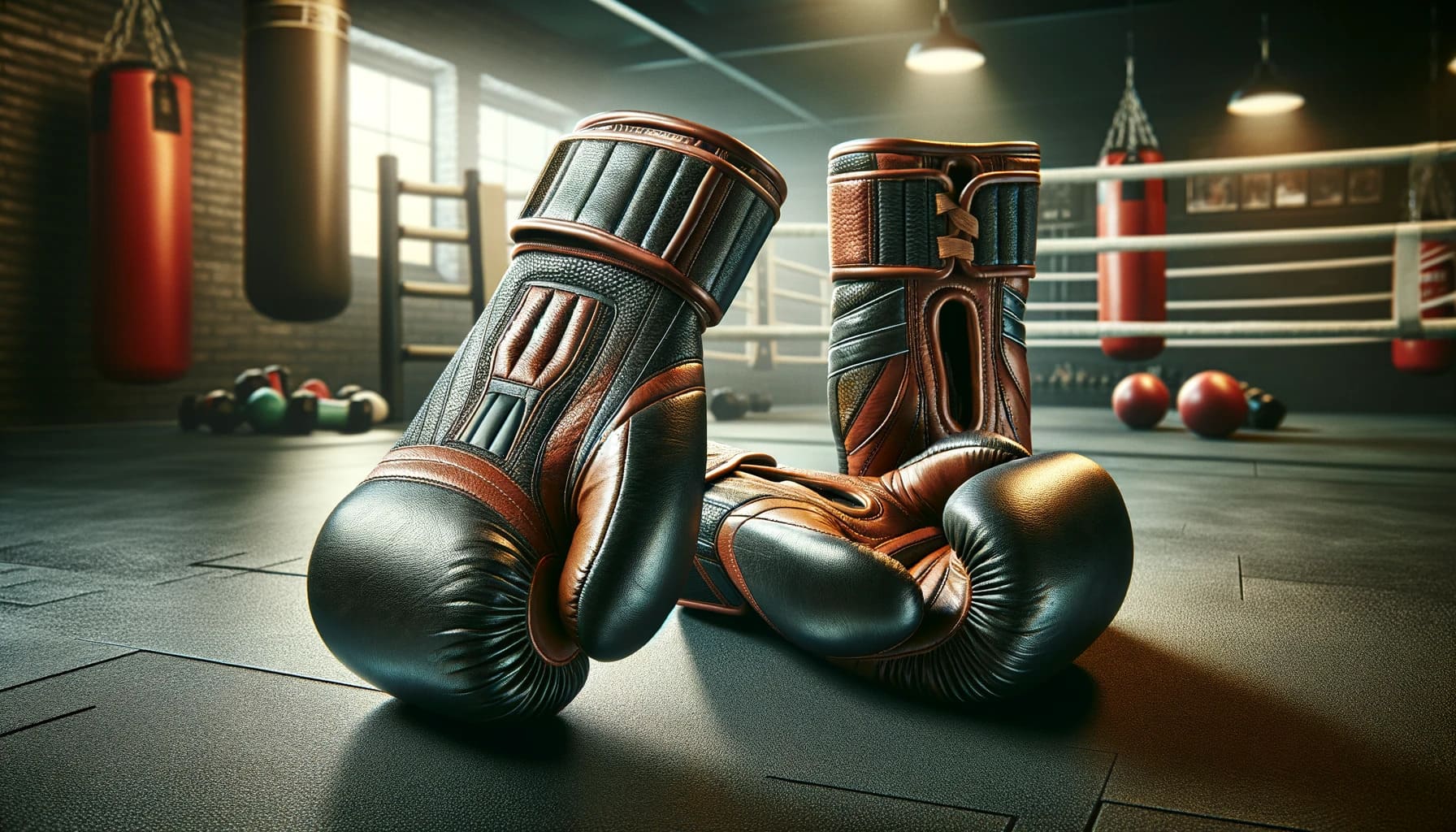Boxing gloves, the quintessential gear of the sport, are crafted primarily from leather or synthetic materials, enveloping layers of foam padding. This composition ensures both durability and protection, pivotal for the safety and efficacy of every punch thrown in the ring.
Materials Used in Boxing Glove Construction
When it comes to crafting boxing gloves, the choice of material is not just a matter of appearance; it’s about functionality, durability, and comfort. The most common materials include cowhide leather, buffalo leather, goatskin, synthetic leather, and microfiber.

Each material brings unique properties to the gloves:
- Cowhide Leather: Renowned for its durability and flexibility, cowhide leather is a popular choice for high-quality gloves.
- Buffalo and Goatskin Leather: Both are valued for their toughness and adaptability.
- Synthetic Leather: Often used as a cost-effective alternative, synthetic materials like polyurethane (PU) and vinyl vary in quality. While they may not always match the longevity of genuine leather, advancements have made high-grade synthetic gloves almost indistinguishable from their leather counterparts.
The assembly of these materials is a meticulous process, ensuring each glove provides the necessary protection, comfort, and resilience required in the sport.
Evolution of Boxing Glove Materials
The evolution of boxing gloves is a fascinating journey through time, mirroring the sport’s own evolution. Let’s explore the key stages:
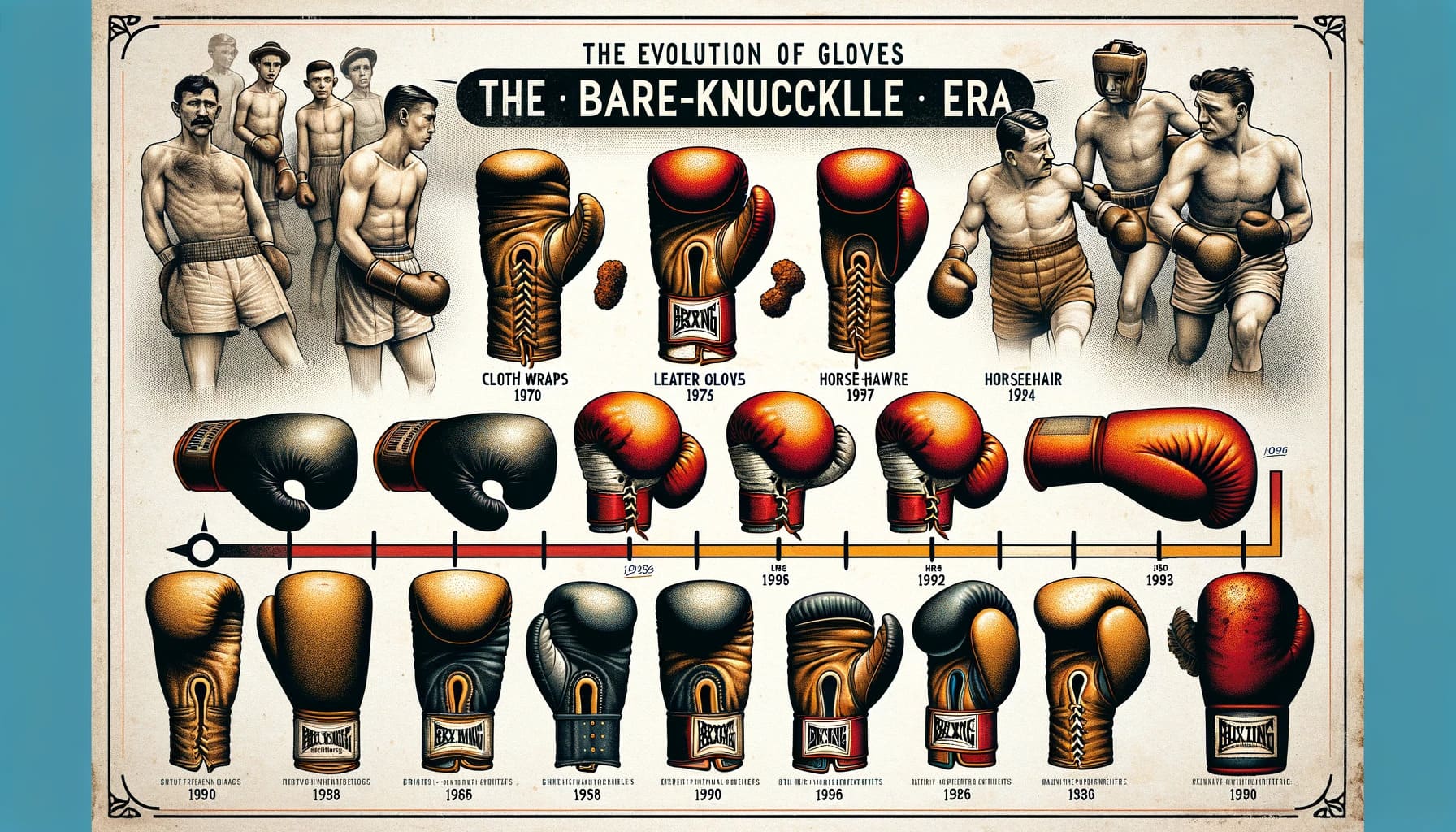
- Bare-Knuckle Era:
Initially, fighters wrapped their hands with cloth or leather, offering minimal protection. This era was characterized by brutal, lengthy bouts with significant injury risks. - Early Glove Era:
Marking a pivotal change, padded gloves made from horsehair and leather were introduced. These gloves, although offering better protection, were heavy and cumbersome. - Modern Glove Era:
The era saw a standardization of gloves, introducing softer materials like foam for padding, making gloves lighter and safer. - Contemporary Era:
Today’s gloves incorporate advanced synthetic materials like neoprene or polyurethane, ensuring better protection and comfort for the athletes.
Through each stage, boxing gloves have become more sophisticated, reflecting technological advancements and a growing emphasis on safety and fairness in the sport.
Choosing Boxing Gloves Based on Material and Quality
Selecting the right boxing gloves is more than just picking a size and color; it’s about understanding the materials and quality that suit your boxing style and needs.

Here are key factors to consider:
- Material: Real leather gloves offer durability and a premium feel, molding to the shape of your hands over time. PU leather is more affordable and requires less upkeep but may not last as long.
- Size and Weight: Boxing gloves are measured in ounces, correlating with the amount of padding and protection they offer. Ensure a comfortable fit, with your fingertips touching the top of the gloves.
- Craftsmanship: Look for gloves with double stitching, especially at high-stress points like the thumb connection and edges. A quality inner lining enhances comfort and durability.
Investing time in choosing the right gloves can significantly impact your boxing experience, offering a balance of protection, comfort, and performance.
Choosing the right Material and Quality
When selecting boxing gloves, the material and quality are crucial factors that directly influence your performance, comfort, and the gloves’ longevity. Understanding the nuances of each material can help you make an informed decision tailored to your boxing style, frequency of use, and personal preferences. Here’s a practical guide on the materials used in boxing gloves, highlighting their benefits and drawbacks.
Leather Boxing Gloves
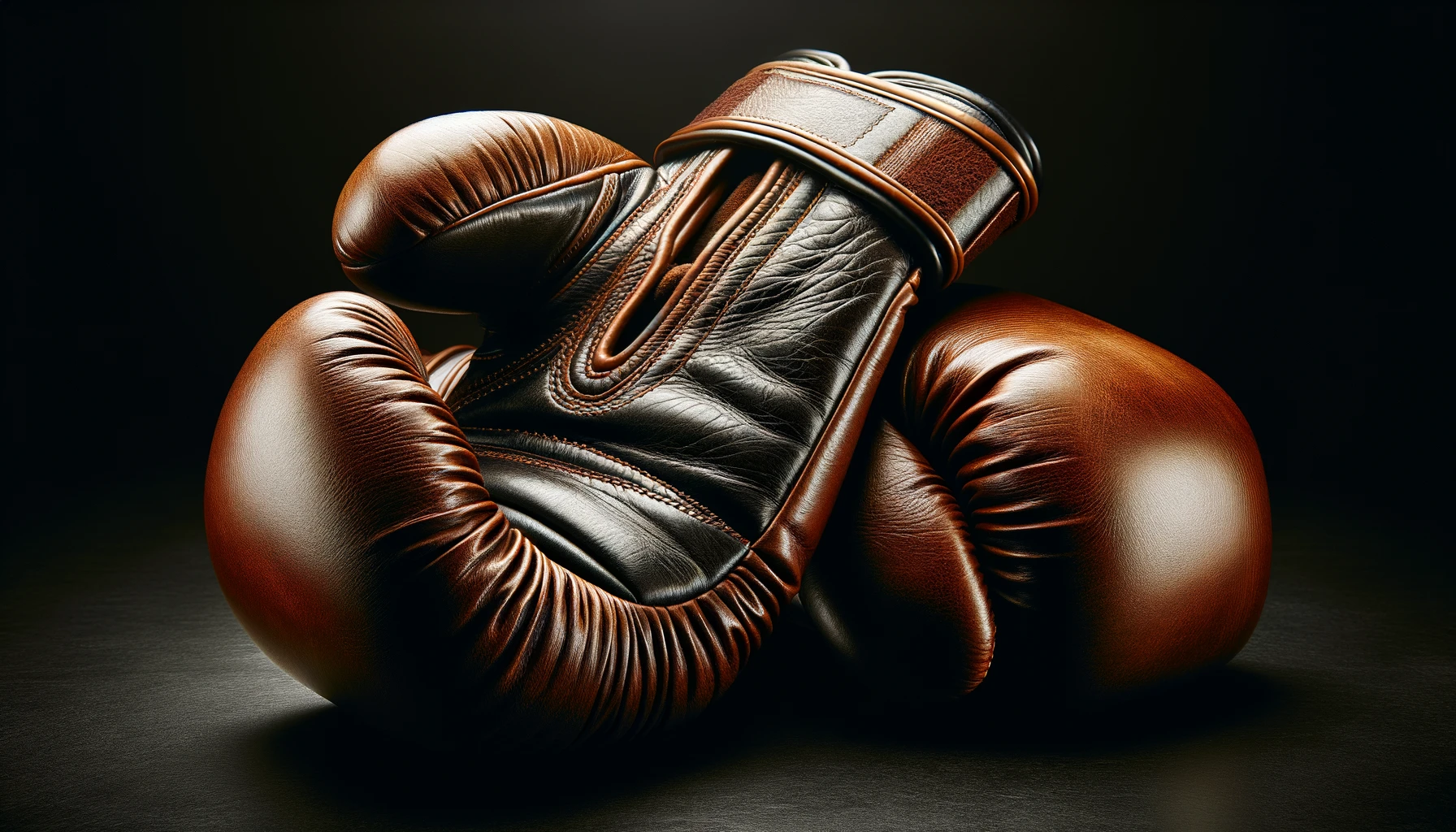
Benefits:
- Durability: Genuine leather gloves are renowned for their long-lasting durability. They can withstand rigorous training sessions and fights, making them a preferred choice for professional boxers.
- Comfort and Fit: Leather naturally adjusts to the shape of your hand over time, offering a personalized fit. This enhances grip strength and punch accuracy.
- Breathability: High-quality leather provides better air circulation, reducing sweat accumulation and increasing comfort during long training sessions.
Negatives:
- Cost: Leather gloves tend to be more expensive due to the quality and longevity they offer. This might be a consideration for beginners or those on a tight budget.
- Maintenance: They require more care, including regular cleaning and conditioning to maintain their integrity and prevent them from drying out or cracking.
Synthetic Leather Gloves (PU/PVC)
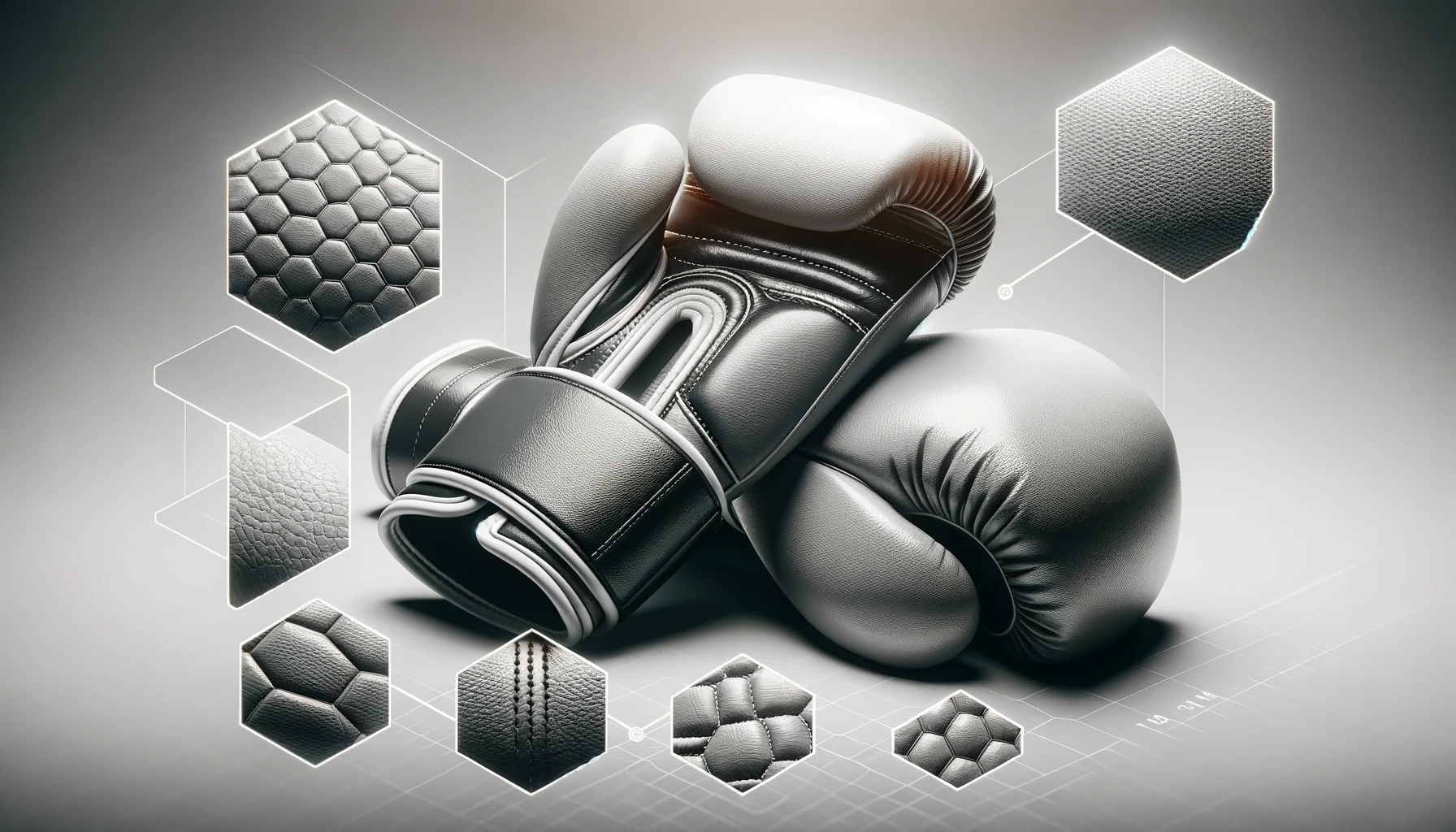
Benefits:
- Affordability: Synthetic materials like PU (polyurethane) or PVC (polyvinyl chloride) are cost-effective alternatives to genuine leather, making them accessible to beginners or those needing a budget-friendly option.
- Ease of Maintenance: These gloves are easier to clean and maintain compared to their leather counterparts, often requiring just a simple wipe-down after use.
Negatives:
- Durability: Synthetic gloves are less durable than leather gloves. They may peel, crack, or wear out faster, especially under heavy use.
- Comfort and Fit: While advancements have improved the quality of synthetic gloves, they generally do not offer the same level of breathability or custom fit as leather gloves. This might lead to discomfort or reduced performance during extended training sessions.
Vinyl Gloves
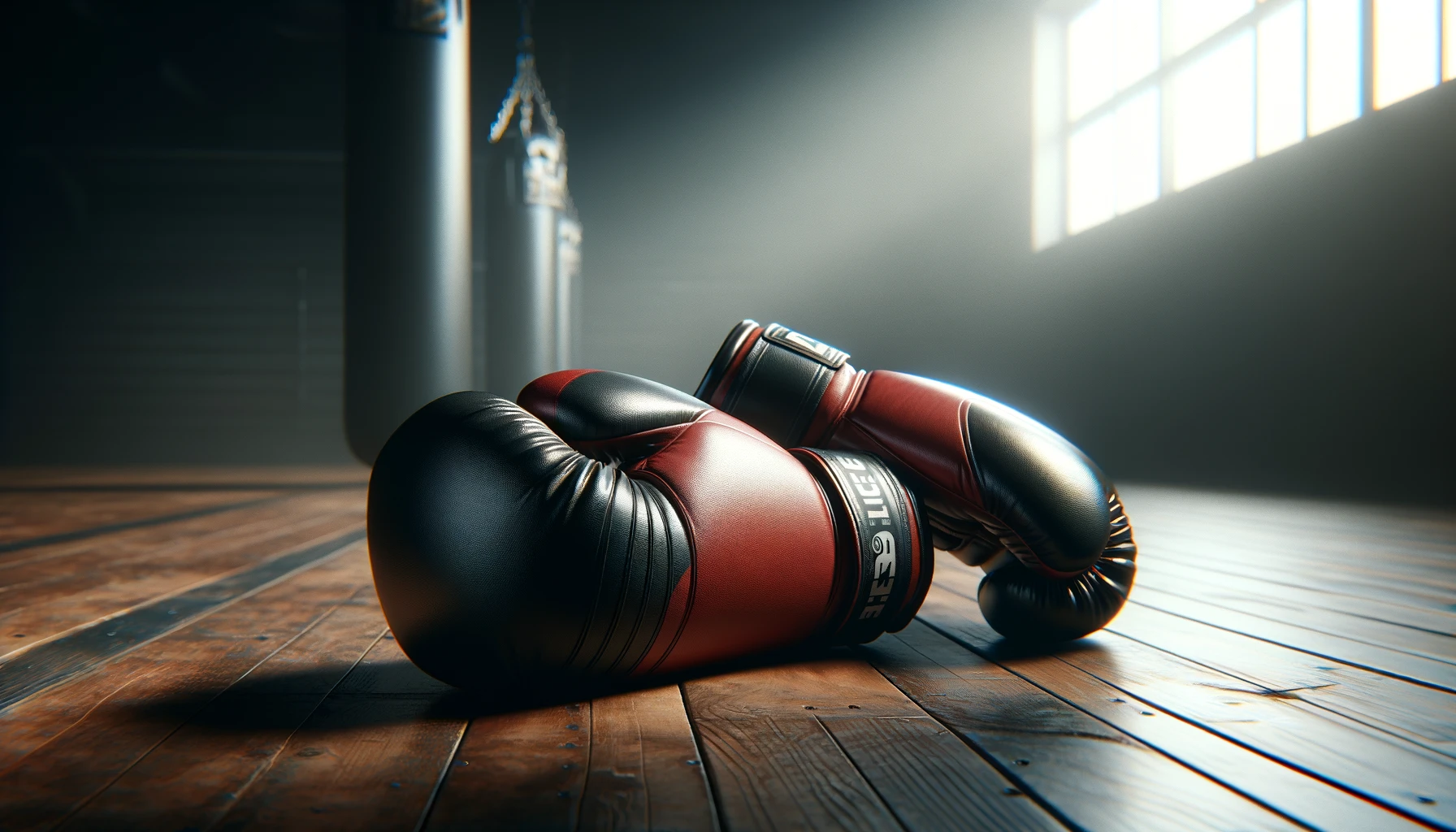
Benefits:
- Water Resistance: Vinyl gloves are water-resistant, making them easy to clean and suitable for outdoor training where they might be exposed to moisture.
- Cost-Effective: They are among the most affordable options, appealing to beginners or those looking for a low-cost entry into boxing.
Negatives:
- Breathability and Comfort: Vinyl is less breathable than leather and some synthetics, which can lead to increased sweating and discomfort during use.
- Durability: Similar to other synthetic gloves, vinyl gloves have a shorter lifespan and are prone to damage from repeated impact.
Making Your Choice
When choosing boxing gloves, consider how often you plan to train, your budget, and personal preferences for comfort and fit. For those committed to boxing long-term or training frequently, investing in a pair of high-quality leather gloves may be worthwhile for their durability and superior fit. Beginners or casual practitioners might prefer the affordability and ease of maintenance offered by synthetic or vinyl gloves, with the understanding that they may need to be replaced more frequently.
Ultimately, the right glove material for you should enhance your boxing experience, offering a balance of comfort, protection, and durability that meets your specific needs and goals in the sport.
Safety Standards and Regulations for Boxing Gloves
Boxing gloves are not just about performance; they are also bound by safety standards and regulations. Key points include:

- Regulatory Bodies: Organizations like the World Boxing Association (WBA) and International Boxing Federation (IBF) set standards for glove weight, padding, and materials to ensure fighter safety and fair play.
- Protection: Properly regulated gloves reduce the risk of injuries like cuts and fractures by cushioning the impact and distributing force.
- Differences in Standards: Amateur and professional boxing gloves have distinct requirements. Amateur gloves focus more on safety, while professional gloves are designed for power and precision.
- Maintenance and Inspection: Regular checks for wear and tear are essential to maintain glove integrity and protective qualities.
These regulations and guidelines play a crucial role in making boxing a safer sport for its athletes.
Picking Professional Boxing Gloves
Ready to step into the ring for a professional bout? Choosing gloves that meet the strict standards of boxing’s governing bodies is crucial. Let’s make this easy and a bit fun, with a quick checklist to ensure your gloves are up to the task for official fights.
Know Your Regulators
- World Boxing Association (WBA) rules
- International Boxing Federation (IBF)
- World Boxing Council (WBC)
- World Boxing Organization (WBO)
Each organization has its own set of rules, but here are the key points they all focus on:
Weight Matters
- Gloves typically range from 8 to 10 ounces.
| Weight Class | Glove Weight |
|---|---|
| Flyweight (up to 112 lb / 51 kg) | 8 oz |
| Bantamweight (118 lb / 53.5 kg) | 8 oz |
| Featherweight (126 lb / 57 kg) | 8 oz |
| Lightweight (135 lb / 61.2 kg) | 8 oz |
| Welterweight (147 lb / 66.7 kg) | 10 oz |
| Middleweight (160 lb / 72.6 kg) | 10 oz |
| Light Heavyweight (175 lb / 79.4 kg) | 10 oz |
| Heavyweight (over 175 lb / 79.4 kg) | 10 oz |
Important: Always check with the specific boxing organization (e.g., WBA, WBC, IBF, WBO) for their latest regulations and requirements, as they may have specific rules that slightly adjust these general guidelines.
Padding is Key
- Ensure there’s adequate padding, especially around the knuckle area. Safety first!
Material Check
- Leather reigns supreme for its durability and comfort. Make sure your gloves are made from genuine leather to pass inspection.
Color Code
- Some organizations prefer red or blue gloves for better visibility during scoring. Check if there’s a preference for your fight.
Seal of Approval
- Look for gloves that specifically mention compliance with your organization’s standards. Brands often highlight which gloves are designed for professional fights.
Quick Tips for Glove Success
- Research: Before buying, check the latest regulations from the specific body governing your fight.
- Quality Over Price: Don’t skimp on gloves. Investing in high-quality, compliant gloves is investing in your boxing future.
- Consult with Veterans: Talk to coaches or seasoned fighters. They can offer insights on the best gloves for official bouts.
Choosing the right gloves for professional boxing doesn’t have to be a knockout challenge. Keep this guide handy, and you’ll find the perfect pair that keeps the refs happy and gives you the edge in the ring. Ready to fight? Glove up!
Conclusion
In exploring the fabric of boxing gloves, we’ve journeyed through the materials, history, selection criteria, and safety standards that define these essential tools of the sport. From the early days of bare-knuckle boxing to the modern era of high-tech materials, the evolution of boxing gloves reflects the sport’s commitment to safety, performance, and innovation. Whether you’re a beginner or a seasoned boxer, understanding what your gloves are made of, how they’ve evolved, and the standards they adhere to, can deepen your appreciation for this crucial piece of equipment.
Remember, the right gloves are more than protective gear; they’re a boxer’s companion in every punch, every block, and every victory.
FAQ’s
What materials are commonly used in boxing gloves?
Boxing gloves are typically made of leather or synthetic materials like polyurethane or vinyl for the outer layer, with foam padding inside for shock absorption.
Are real leather boxing gloves better than synthetic ones?
Real leather gloves are often more durable and comfortable but may be more expensive than synthetic gloves, which are more affordable and easier to clean.
What kind of padding is used inside boxing gloves?
The padding in boxing gloves is usually made of layered foam, horsehair, or a combination of both, designed to absorb impact and protect the hands.
How does the material of boxing gloves impact performance?
The glove material can affect the glove's weight, comfort, breathability, and overall performance. Leather gloves tend to be more breathable and durable, while synthetic gloves are lighter and easier to maintain.
Can boxing gloves materials affect skin sensitivity?
Yes, individuals with sensitive skin may react to certain materials used in gloves, such as latex or certain dyes and chemicals in synthetic gloves.
Are there environmentally friendly materials used in boxing gloves?
Some manufacturers use eco-friendly materials like recycled fabrics or sustainable leather in their boxing gloves to reduce environmental impact.
How often should boxing gloves be replaced based on their material?
The lifespan of boxing gloves depends on their material quality and how often they are used. High-quality leather gloves can last several years with proper care, while synthetic gloves may need to be replaced more frequently.
What is the best way to clean and maintain different types of boxing gloves?
For leather gloves, use a leather cleaner and conditioner. For synthetic gloves, wiping with a damp cloth and mild soap is usually sufficient. Always air dry gloves away from direct heat.
